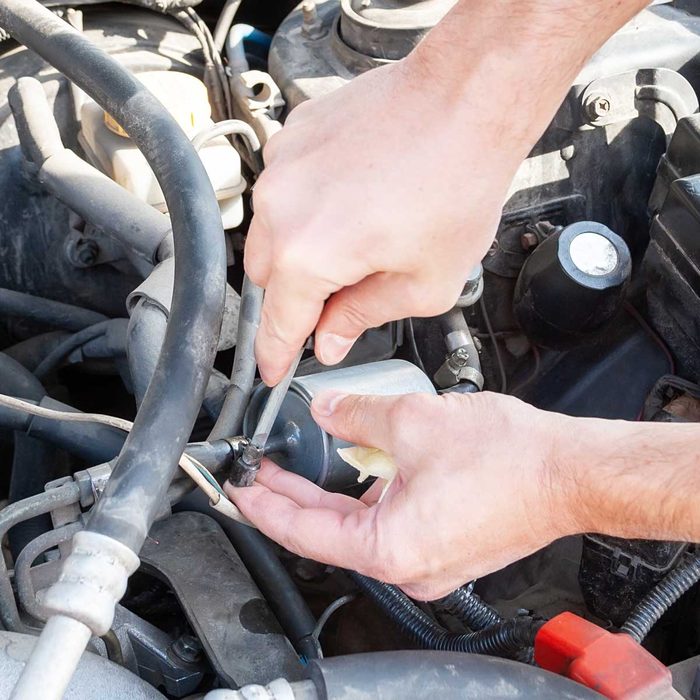5 Signs Your Fuel Filter Needs Replacing
Updated: Feb. 22, 2024

Unseen and often forgotten, fuel filters are a small but critical part of a vehicle's fuel supply system. Here's what can happen if you neglect yours.
It’s easy to forget about your car’s fuel filters, but you may regret it if you do. Here’s what you need to know to protect your fuel supply system and maintain a smooth ride.
Most vehicles have two fuel filters. There’s one in the fuel tank, often called a strainer (which costs $25 to $100) and one in the main fuel line (usually less than $20). The filter material is made from plastic or specially coated pleated paper. Fuel filters are designed to trap dirt, rust, scale and other impurities from entering the fuel pump, fuel injectors and engine, without effecting fuel pressure.
Gasoline fuel filters are rated in microns. Most modern vehicles with fuel-injection systems use filters rated between 10 and 30 microns. (A micron is .001mm. By comparison, a human hair is approximately 70 microns or .08mm.) This is critical because modern engines have extremely tight fuel system and engine component tolerances. Due to their abrasive nature, combined with the high fuel pressure of fuel-injected engines, any foreign particles that gets past a faulty or dirty fuel filter can cause blockages that interrupt the fuel supply and damage your engine.
5 Signs of a Bad Fuel Filter
On This Page
Poor Engine Performance
Under heavy loads, a clogged fuel filter may cause the engine to randomly hesitate, surge or sputter. This tends to be more prominent when accelerating, especially up a steep incline. Although there may be no symptoms under normal driving conditions, a clogged fuel filter will starve the engine of the extra fuel needed when quickly accelerating. Depending on the extent of the fuel restriction caused by a dirty filter, an engine may also shake or stutter at different speeds.
Hard Starting
Unless totally blocked, rarely will a bad fuel filter keep your engine from starting. On a vehicle where a fuel filter has never been changed, the dirty filter can cause erratic fuel flow, resulting in longer than usual cranking before the engine starts. Check your owner’s manual on filter replacement intervals.
Stalling
An engine that repeatedly stalls while driving could be warning you of a dirty fuel filter. Again, depending on the severity of the clog, your car may start right back up without any noticeable loss of power. As the clog worsens and fuel delivery becomes more sporadic, stalling becomes excessive or worsens on acceleration. It’s likely the filter is getting completely clogged and it’s time for a replacement.
Random Misfire or Rough Idle
A clogged fuel filter causes low fuel pressure that results in a lean fuel condition and engine misfire. This can result in poor fuel mileage, rough idling and possibly cause the check engine light to come on. Once that light is on, it’s time for a trip to the repair shop.
Fuel System Part Failures
A noisy, damaged or failed fuel pump can be the caused by a restricted fuel filter. A clogged fuel filter prevents the correct amount of fuel from reaching the engine. The fuel pump will try to compensate for a bad fuel filter, placing undue pressure on the fuel pump motor causing the pump to fail prematurely.
Contaminates that get past a dirty fuel filter can damage, clog or cause a fuel injector to leak, leading to all types of engine drivability problems. Unless totally failed, replacing a dirty fuel filter and servicing or flushing the injectors (done by the pros) should get you back on the road with minimal expense.
The main line fuel filter is replaceable. But before you go the DIY route, be sure the engine is cool, you have the proper tools, and you release fuel system pressure by pulling the fuel pump fuse (check the owner’s manual for its location) and running the engine until it shuts off. Releasing fuel pressure is critical because you do not want gas spraying all over the engine or ground. Be safe and have a fire extinguisher nearby anyway.
Replace all O-rings, gaskets and seals. Replace all mounting brackets and check to make sure all retaining clips are correctly reinstalled. Of course, check for leaks after installing.
There are several other reasons for loss of engine power and drivability problems, but it’s worth checking the condition of the fuel filter first. It’s an inexpensive and easy fix.




















